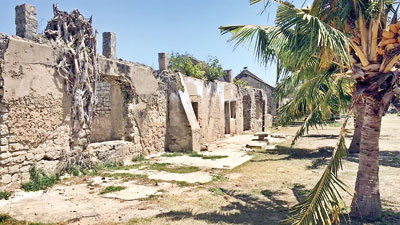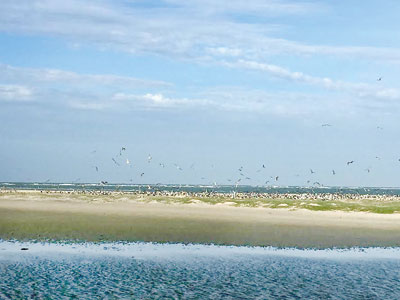Cycling through Mannar

Crumbling: The remains of the Fort
The wind swept through my hair, tugging and tousling it. Droplets of water sprayed my skin. I could taste the salt. There were occasional thuds and jerks as the boat battled with waves. We were on a navy gun boat, speeding towards Bird Island. We approached one of the islands that form Adam’s Bridge, a chain of 16 islands stretching from Pamban Island in India to Mannar Island in Sri Lanka. The boat slowed down. The water was becoming too shallow. A quick boat transfer and a second journey followed. From a distance we could see birds lazily circling above an island whilst others swooped downwards to re-join their chicks. There was a cacophony of noise; caws and shrieks. Jumping off the boat onto soft, smooth, silky sand we could see hundreds and hundreds of birds. We had arrived on Bird Island.
My first impression was of hundreds of wings, beaks and legs, weaving in and out of view, flashing brightly as the sunlight hit them, then disappearing, lost in the mass of feathers and beaks. Then came the smell; sharp, acidic, almost over-powering at first. Gradually the mass of birds began to separate into individuals, each bird intently scurrying around. Standing on the beach and keeping a distance from the birds, we viewed the nesting colony through our optics. Here, groups of adults, juveniles and eggs could be seen. Broken shells were scattered on the ground. Amongst the fragments of shell patches of vibrant orange from spilled egg yolk stood out against the sand; the broken shells symbolize both life and death.
This colony of birds mostly consists of large crested terns. Sooty terns and brown noddies can be seen on the opposite end of the island. Disturbance to nesting colonies from visitors could have catastrophic consequences. Therefore, special permission from the Navy is required to land on the island. I was fortunate that I was able to visit with a group who were conducting a periodic count. The counters stayed on the shoreline to keep disturbance to a minimum. An estimate derived later with the aid of photographs revealed that there were over three thousand adult large crested terns in the nesting colony.
The islands are known to shift shape over time as the currents drag and deposit sand. I was told that some time ago, it was possible to drive from Mannar Island to the first two islands on the Adam’s Bridge chain as the shifting sands had filled in the shallows. At this point in time there is no visible surface connection. High tide had left its mark on the land as clumps of seaweed and an outline of the waves could be seen, and there were pools of water which connect to the sea through channels of ice cold water. Paddling in this water was a refreshing respite from the harsh mid-morning sun.

Bird Island: A sea of birds
On our return, the harsh light that now illuminated the pier was a stark contrast to the soft sunlight that had bathed the pier early in the morning. The lighthouse which had been silhouetted against a sky of brilliant orange, pink and purple now stood out brilliant and white in the strong mid-morning Mannar sun. We walked across the wooden slats, through which there were blue flashes. The rusting iron columns and wooden slats give the pier character. Standing on the pier, with the ocean surrounding me, the sound of the sea and the wind in my hair, I felt calm.
Mannar has been shaped by the sea. The people and the buildings depict this influence which ranges from the weather-beaten fisher folk to the presence of lighthouses and a historic fort. Our exploration on bicycle the previous day had resulted in a wide loop around the area as we tried to navigate back to the road hampered by the unfortunate combination of the fact that we did not know our exact location, the muddy ground and the rapidly darkening day. Trees were sparse and shrubs were the predominant form of vegetation. The area is unpopulated; our encounters with humans were brief. We cycled past a group of children and a man driving a bullock cart. Far more frequent were the wild donkeys that roam freely in this area.
The next day we set out on another cycle ride with more confidence, reassured by the presence of Ashan Seneviratne of Little Adventures who was with us. Cycling around Mannar, whether it be on the main road, or on dirt tracks is a more intimate way to explore the area. We came upon an abandoned lighthouse and climbed the narrow, spiralling stairs only to discover a friendly bat and a barricade which forced us to abandon our exploration. We cycled further. The path continued onwards to the coast where several colourful boats were docked and fishing nets were spread out. On our return we chose to go down a dimly lit pathway and cycled through a setting reminiscent of the enchanted forest in Sleeping Beauty as branches reached out from the depths of the shrub forest and sharp white thorns threateningly skimmed our clothes.
Darkness approached. The constant murmur of cicadas was interrupted by occasional thuds as frogs abandoned walls in favour of the floor. Tiny moths fluttered around, entranced by the lights. Gazing up at the star-filled sky I could see constellations far clearer than I had seen them before.
We then set off for the Mannar Fort. Standing outside, I could see archways and windows through which the layout of the fort could be seen. Rust-red bricks peep through plaster and concrete and the walls are decked with moss and assorted plants. There is a stone ramp leading to the upper level which offers a panoramic view of the sea and surrounding land. Several deep wells lie partially concealed; dug into the ground, an unpleasant surprise for anyone who attempts to wander around the fort at night. Sunlight streams into the fort and the fronds of the coconut tree rustle gently in the breeze. This is a sharp contrast to the pitch black, bat-filled dungeon used for imprisoning prisoners. The thick walls probably served to muffle the shouts from within.
The visit had been eye-opening. Having never been to Mannar before, I was surprised at its beauty and the confluence of nature, history and the present. I would love to spend more time exploring it. It was time to leave but I remained standing on the ramparts, wanting to hold on to the moment. A gull swooped through the air, a white blur against an azure sky. I looked out at the sparkling blue sea as the wind swept through my hair.


